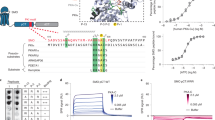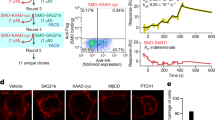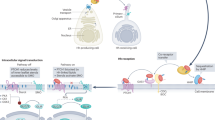Abstract
Patched1 (PTCH1) is one of the key molecules involved in the Hedgehog (HH) signaling pathway and acts as the receptor of HH ligands. Additionally, PTCH1 inhibits the positive signal transductor Smoothened (SMO). Several PTCH1 splice variants are known but the functional differences among them are not clear. Here, we demonstrate the unique biological properties of the PTCH1 isoforms generated by alternative first exon usage. All isoforms examined worked as functional receptors of both Sonic HH and Desert HH. However, the signaling upregulated isoforms PTCH1-1B and -1C inhibited SMO and the pathway transcription factors glioma 1 (GLI1) and GLI2 to a higher extent than PTCH1-1 and -1Ckid. Moreover, in situ hybridizations allowed the detection of the Ptch1 isoforms in specific structures of the developing mouse embryo. Additionally, the differences in the N-terminal tail had a dramatic influence on the steady states of the proteins, with PTCH1-1B and -1C levels being significantly higher than PTCH1-1 and -1Ckid. This implies that the pronounced signaling inhibitory properties of PTCH1-1B and -1C may be mostly due to this high-protein expression rather than to intrinsic functional differences. Thus, our study supports a role of splicing variation and promoter choice for HH signaling regulation.
This is a preview of subscription content, access via your institution
Access options
Subscribe to this journal
Receive 50 print issues and online access
$259.00 per year
only $5.18 per issue
Buy this article
- Purchase on Springer Link
- Instant access to full article PDF
Prices may be subject to local taxes which are calculated during checkout






Similar content being viewed by others
References
Ågren M, Kogerman P, Kleman MI, Wessling M, Toftgård R . (2004). Expression of the PTCH1 tumor suppressor gene is regulated by alternative promoters and a single functional Gli-binding site. Gene 330: 101–114.
Bai CB, Auerbach W, Lee JS, Stephen D, Joyner AL . (2002). Gli2, but not Gli1, is required for initial Shh signaling and ectopic activation of the Shh pathway. Development 129: 4753–4761.
Carninci P, Sandelin A, Lenhard B, Katayama S, Shimokawa K, Ponjavic J et al. (2006). Genome-wide analysis of mammalian promoter architecture and evolution. Nat Genet 38: 626–635.
Carpenter D, Stone DM, Brush J, Ryan A, Armanini M, Frantz G et al. (1998). Characterization of two patched receptors for the vertebrate hedgehog protein family. Proc Natl Acad Sci USA 95: 13630–13634.
Eichberger T, Sander V, Schnidar H, Regl G, Kasper M, Schmid C et al. (2006). Overlapping and distinct transcriptional regulator properties of the GLI1 and GLI2 oncogenes. Genomics 87: 616–632.
Goodrich LV, Milenkovic L, Higgins KM, Scott MP . (1997). Altered neural cell fates and medulloblastoma in mouse patched mutants. Science 277: 1109–1113.
Hahn H, Christiansen J, Wicking C, Zaphiropoulos PG, Chidambaram A, Gerrard B et al. (1996a). A mammalian patched homolog is expressed in target tissues of sonic hedgehog and maps to a region associated with developmental abnormalities. J Biol Chem 271: 12125–12128.
Hahn H, Wicking C, Zaphiropoulos PG, Gailani MR, Shanley S, Chidambaram A et al. (1996b). Mutations of the human homolog of Drosophila patched in the nevoid basal cell carcinoma syndrome. Cell 85: 841–851.
Hahn H, Wojnowski L, Zimmer AM, Hall J, Miller G, Zimmer A . (1998). Rhabdomyosarcomas and radiation hypersensitivity in a mouse model of Gorlin syndrome. Nat Med 4: 619–622.
Hughes TA . (2006). Regulation of gene expression by alternative untranslated regions. Trends Genet 22: 119–122.
Johnson RL, Rothman AL, Xie J, Goodrich LV, Bare JW, Bonifas JM et al. (1996). Human homolog of patched, a candidate gene for the basal cell nevus syndrome. Science 272: 1668–1671.
Kalderon D . (2005). The mechanism of hedgehog signal transduction. Biochem Soc Trans 33: 1509–1512.
Kampa D, Cheng J, Kapranov P, Yamanaka M, Brubaker S, Cawley S et al. (2004). Novel RNAs identified from an in-depth analysis of the transcriptome of human chromosomes 21 and 22. Genome Res 14: 331–342.
Kogerman P, Krause D, Rahnama F, Kogerman L, Unden AB, Zaphiropoulos PG et al. (2002). Alternative first exons of PTCH1 are differentially regulated in vivo and may confer different functions to the PTCH1 protein. Oncogene 21: 6007–6016.
Lee Y, Miller HL, Russell HR, Boyd K, Curran T, McKinnon PJ . (2006). Patched2 modulates tumorigenesis in patched1 heterozygous mice. Cancer Res 66: 6964–6971.
Liu W, Li G, Chien JS, Raft S, Zhang H, Chiang C et al. (2002). Sonic hedgehog regulates otic capsule chondrogenesis and inner ear development in the mouse embryo. Dev Biol 248: 240–250.
Motoyama J, Takabatake T, Takeshima K, Hui C . (1998). Ptch2, a second mouse Patched gene is co-expressed with Sonic hedgehog. Nat Genet 18: 104–106.
Nagao K, Toyoda M, Takeuchi-Inoue K, Fujii K, Yamada M, Miyashita T . (2005). Identification and characterization of multiple isoforms of a murine and human tumor suppressor, patched, having distinct first exons. Genomics 85: 462–471.
Nybakken K, Vokes SA, Lin TY, McMahon AP, Perrimon N . (2005). A genome-wide RNA interference screen in Drosophila melanogaster cells for new components of the Hh signaling pathway. Nat Genet 37: 1323–1332.
Rahnama F, Shimokawa T, Lauth M, Finta C, Kogerman P, Teglund S et al. (2006). Inhibition of GLI1 gene activation by Patched1. Biochem J 394: 19–26.
Rahnama F, Toftgård R, Zaphiropoulos PG . (2004). Distinct roles of PTCH2 splice variants in Hedgehog signalling. Biochem J 378: 325–334.
Roessler E, Ermilov AN, Grange DK, Wang A, Grachtchouk M, Dlugosz AA et al. (2005). A previously unidentified amino-terminal domain regulates transcriptional activity of wild-type and disease-associated human GLI2. Hum Mol Genet 14: 2181–2188.
Sanchez P, Hernandez AM, Stecca B, Kahler AJ, DeGueme AM, Barrett A et al. (2004). Inhibition of prostate cancer proliferation by interference with SONIC HEDGEHOG-GLI1 signaling. Proc Natl Acad Sci USA 101: 12561–12566.
Shimokawa T, Rahnama F, Zaphiropoulos PG . (2004). A novel first exon of the Patched1 gene is upregulated by Hedgehog signaling resulting in a protein with pathway inhibitory functions. FEBS Lett 578: 157–162.
Smyth I, Narang MA, Evans T, Heimann C, Nakamura Y, Chenevix-Trench G et al. (1999). Isolation and characterization of human patched 2 (PTCH2), a putative tumour suppressor gene inbasal cell carcinoma and medulloblastoma on chromosome 1p32. Hum Mol Genet 8: 291–297.
Smyth I, Wicking C, Wainwright B, Chenevix-Trench G . (1998). The effects of splice site mutations in patients with naevoid basal cell carcinoma syndrome. Hum Genet 102: 598–601.
Speek M, Njunkova O, Pata I, Valdre E, Kogerman P . (2006). A potential role of alternative splicing in the regulation of the transcriptional activity of human GLI2 in gonadal tissues. BMC Mol Biol 7: 13.
Svärd J, Heby-Henricson K, Persson-Lek M, Rozell B, Lauth M, Bergström Å et al. (2006). Genetic elimination of suppressor of fused reveals an essential repressor function in the mammalian Hedgehog signaling pathway. Dev Cell 10: 187–197.
Uchikawa H, Toyoda M, Nagao K, Miyauchi H, Nishikawa R, Fujii K et al. (2006). Brain- and heart-specific Patched-1 containing exon 12b is a dominant negative isoform and is expressed in medulloblastomas. Biochem Biophys Res Commun 349: 277–283.
Wang XQ, Rothnagel JA . (2001). Post-transcriptional regulation of the GLI1 oncogene by the expression of alternative 5′ untranslated regions. J Biol Chem 276: 1311–1316.
Zaphiropoulos PG, Unden AB, Rahnama F, Hollingsworth RE, Toftgård R . (1999). PTCH2, a novel human patched gene, undergoing alternative splicing and up-regulated in basal cell carcinomas. Cancer Res 59: 787–792.
Acknowledgements
We thank Drs Fritz Aberger (University of Salzburg), Maximilian Muenke (NIH), Yusuke Nakamura and Yoichi Furukawa (University of Tokyo), and Fahimeh Rahnama (Karolinska Institute) for reporter and expression plasmids. We are grateful to C Finta, M Lauth, V Jaks, R Palaniswamy and Å Bergström for helpful discussions and technical support. T Shimokawa was supported by a Marie Curie International Incoming Fellowship. This project was supported by the Swedish Cancer Fund and the Magn. Bezgvalls foundation.
The PTCH1-1CΔE2, -1Ckid and -1CkidΔE2 sequences were submitted to the GenBank with accession numbers AB212827, AB239328 and AB212829, respectively.
Author information
Authors and Affiliations
Corresponding authors
Additional information
Supplementary Information accompanies the paper on the Oncogene website (http://www.nature.com/onc).
Supplementary information
Rights and permissions
About this article
Cite this article
Shimokawa, T., Svärd, J., Heby-Henricson, K. et al. Distinct roles of first exon variants of the tumor-suppressor Patched1 in Hedgehog signaling. Oncogene 26, 4889–4896 (2007). https://doi.org/10.1038/sj.onc.1210301
Received:
Revised:
Accepted:
Published:
Issue Date:
DOI: https://doi.org/10.1038/sj.onc.1210301
Keywords
This article is cited by
-
The implications of alternative pre-mRNA splicing in cell signal transduction
Experimental & Molecular Medicine (2023)
-
A novel splicing mutation of PTCH1 in a Chinese family with nevoid basal cell carcinoma syndrome
Medical Molecular Morphology (2019)
-
PTCH1 isoform 1b is the major transcript in the development of basal cell nevus syndrome
Journal of Human Genetics (2018)
-
Genetic variations regulate alternative splicing in the 5' untranslated regions of the mouse glioma-associated oncogene 1, Gli1
BMC Molecular Biology (2010)
-
DYRK1B-dependent autocrine-to-paracrine shift of Hedgehog signaling by mutant RAS
Nature Structural & Molecular Biology (2010)



